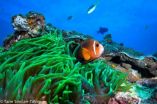(Press-News.org) New research has found clownfish larvae can swim up to 400 kilometres in search of a home, which makes them better able to cope with environmental change.
Clownfish spend their entire adult lives under the protection of their host anemone but as babies they must wander the open ocean, says study co-author, Dr Hugo Harrison from the ARC Centre of Excellence for Coral Reef Studies (Coral CoE) at James Cook University.
"In the past we haven't known where they go, but now we've been given a rare glimpse into how far they can swim, crossing large tracts of ocean to find new homes," he says.
"Knowing how far larvae disperse helps us understand how fish populations can adapt to environmental changes," Dr Harrison says. "The further they can swim, the better they can cope."
As part of the international study, co-author Dr Stephen Simpson from the University of Exeter led a team of researchers to southern Oman, where they collected samples of the only two known populations of the Omani clownfish, Amphiprion omanensis.
"There are only two coral reef systems along this coast and they are separated by 400km of ocean water," Dr Simpson says. "In order to persist, fish must be migrating between these two populations."
The research team collected tissue samples from almost 400 clownfish and used DNA fingerprinting to identify fish that had migrated between the two populations.
"Like the accents that we have that allow us to tell an Englishman from an American, fish populations can develop their own genetic signatures," says Dr Harrison.
"We can look at the signature of each fish and tell whether it belongs there or not. It's like finding an Englishman in New York, they stand out."
The study found the fish were making regular migrations from one population to another and in doing so were travelling across 400km of open ocean.
"That's an epic journey for these little dudes. When they make it back to the reef, they're only a few millimetres long and they have only a few days to make it there so they must be using ocean currents to assist their migration," adds Dr Simpson.
The researchers found that most of the fish travelled from North to South, while very few travelled in the opposite direction.
This direction corresponds to the dominant ocean currents in the region, which are driven by the winter monsoon.
Second generation migrants were also present in both populations, which suggests that after completing their dispersal phase, migrants are settling into anemones and surviving long enough to reproduce.
Dr Simpson says it's the furthest distance they've been able to track the dispersal of any coral reef fish and the findings show how connected the marine environment can be.
"The findings change our understanding of marine populations. They're not small and separate as we often assume, rather this research shows they're often vast and inter-connected," he says.
INFORMATION:
Paper
Long-distance dispersal via ocean currents connects Omani clownfish populations throughout entire species range by Stephen D Simpson, Hugo B Harrison, Michel R Claereboudt, Serge Planes is published in the journal PLOS ONE.
Contact
Dr Hugo Harrison, Coral CoE, +61 (0) 499 523 939, or +61 7 4781 6358, hugo.harrison@my.jcu.edu
Eleanor Gregory, Coral CoE Communications Manager, 0418 655 994, eleanor.gregory@jcu.edu.au
Dr Stephen Simpson, University of Exeter, +44 (0) 7900 551 883 S.Simpson@exeter.ac.uk
Eleanor Gaskarth, University of Exeter Press Office, +44 (0) 7827 309 332, e.f.gaskarth@exeter.ac.uk
Nemo's epic journey to find a new home
2014-09-17
ELSE PRESS RELEASES FROM THIS DATE:
Blood test could identify when cancer treatment has become detrimental
2014-09-17
Some treatments for prostate cancer, while initially effective at controlling the disease, not only stop working over time but actually start driving tumour growth, a major new study shows.
Researchers identified the emergence of drug-resistant cancer cells by testing repeated blood samples from patients with advanced prostate cancer.
They set out a new 'treatment paradigm' – the constant monitoring of patients using a blood test for signs that therapy is becoming counter-productive.
The study was conducted at The Institute of Cancer Research, London, The Royal Marsden ...
Expedition finds Nemo can travel great distances to connect populations
2014-09-17
Clownfish spend their entire lives nestling in the protective tentacles of host anemones, but new research shows that as babies they sometimes travel hundreds of kilometres across the open ocean. Although the process of long-distance dispersal by reef fish has been predicted, this is the first time that the high level exchange of offspring between distant populations has been observed.
Dr Steve Simpson, Senior Lecturer in Marine Biology and Global Change at the University of Exeter, and colleagues from the Australian Research Council Centre of Excellence for Coral Reef ...
Study links physical activity in older adults to brain white-matter integrity
2014-09-17
CHAMPAIGN, Ill. — Like everything else in the body, the white-matter fibers that allow communication between brain regions also decline with age. In a new study, researchers found a strong association between the structural integrity of these white-matter tracts and an older person's level of daily activity – not just the degree to which the person engaged in moderate or vigorous exercise, but also whether he or she was sedentary the rest of the time.
The study, reported in the journal PLOS ONE, tracked physical activity in 88 healthy but "low-fit" participants aged 60 ...
Targeted radiation, drug therapy combo less toxic for recurrent head, neck cancers
2014-09-17
SAN FRANCISCO, Sept. 17, 2014 – Patients with a recurrence of head and neck cancer who have previously received radiation treatment can be treated more quickly, safely and with fewer side effects with high doses of targeted radiation known as Stereotactic Body Radiation Therapy (SBRT) in combination with a drug that also carefully targets cancerous tumors. These findings from a UPMC CancerCenter study were presented today at the American Society of Radiation Oncology (ASTRO) annual meeting in San Francisco.
SBRT uses concentrated radiation beams in high doses to destroy ...
Nature's designs inspire research into new light-based technologies
2014-09-17
BELLINGHAM, Washington, USA -- "Nature has developed, very cleverly, some lessons on how to create the features that we desire in optical design," said Joseph Shaw, director of the Optical Technology Center at Montana State University. "As we explore surfaces and structures at the nanoscale, we'll discover them."
Some of those lessons were presented in San Diego in August during a conference called "The Nature of Light: Light in Nature" chaired by Shaw and Rongguang Liang of the University of Arizona College of Optical Sciences. The conference was part of SPIE Optics ...
In Joslin trial, Asian Americans lower insulin resistance on traditional diet
2014-09-17
BOSTON – September 17, 2014 – Why are Asian Americans at higher risk of developing type 2 diabetes than Caucasian Americans, and prone to develop the disease at lower body weights? One part of this puzzle may lie in the transition from traditional high-fiber, low-fat Asian diets to current westernized diets, which may pose extra risks for those of Asian heritage, says George King, M.D., Senior Vice President and Chief Scientific Officer at Joslin Diabetes Center and the senior author of the study.
A Joslin randomized clinical trial now has demonstrated that both Asian ...
Fighting parents hurt children's ability to recognize and regulate emotions
2014-09-17
Exposure to verbal and physical aggression between parents may hurt a child's ability to identify and control emotions, according to a longitudinal study led by NYU's Steinhardt School of Culture, Education, and Human Development.
The findings, which appear in the journal Development and Psychopathology, also suggest that household chaos and prolonged periods of poverty during early childhood may take a substantial toll on the emotional adjustment of young children.
"Our study points to ways in which aggression between parents may powerfully shape children's emotional ...
Persian Gulf states have new role to play in Israeli-Palestinian conflict resolution
2014-09-17
HOUSTON – (Sept. 17, 2014) – The shifting regional geopolitics of the Middle East have created new opportunities for the Persian Gulf states to engage in Arab-Israeli conflict resolution, according to a new paper from Rice University's Baker Institute for Public Policy.
"The Gulf States and Israeli-Palestinian Conflict Resolution," authored by Kristian Coates Ulrichsen, proposes a set of policy recommendations on how the Gulf states can engage with regional and international partners to create new pathways for action and cooperation. Ulrichsen is the fellow for the Middle ...
Why bioethics literacy matters
2014-09-17
From accessible and affordable health care to reproductive technologies, the justice and well-being of our society depend on the ability of people to identify key issues, articulate their values and concerns, deliberate openly and respectfully, and find the most defensible ways forward. But what are the best educational practices to support these societal conversations?
The Hastings Center and the Presidential Commission for the Study of Bioethical Issues have teamed up to publish a series of essays to highlight the best practices in teaching bioethics and to identify ...
Smallest known galaxy with a supermassive black hole
2014-09-17
SALT LAKE CITY, Sept. 17, 2014 – A University of Utah astronomer and his colleagues discovered that an ultracompact dwarf galaxy harbors a supermassive black hole – the smallest galaxy known to contain such a massive light-sucking object. The finding suggests huge black holes may be more common than previously believed.
"It is the smallest and lightest object that we know of that has a supermassive black hole," says Anil Seth, lead author of an international study of the dwarf galaxy published in Thursday's issue of the journal Nature. "It's also one of the most black ...




